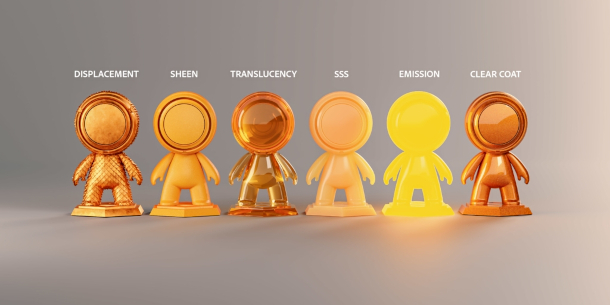Adobe releases Substance 3D Designer 11.2
Substance 3D Designer 11.2 extends Adobe’s material-authoring software into a procedural 3D modelling app, with the new model graph enabling users to kitbash simple geometric shapes to create 3D assets.
Adobe has released Substance 3D Designer 11.2, the next update to its material-authoring software.
That description should now really be ‘material- and model-authoring software’, since the main feature of the update is the new model graph, enabling users to create procedural 3D geometry.
Other changes include five new ray tracing-enabled materials nodes, support for the Adobe Standard Material, and the options to send assets directly to other Substance apps and publish .sbsar files directly.
The release also brings a change of branding for the software which, under Adobe’s old naming convention, would have been Substance Designer 2021.2.
The update shipped yesterday as part of Adobe’s Substance 3D Collection, which also includes new versions of Substance 3D Painter and Substance 3D Sampler, plus new app Substance 3D Stager.
Create procedural 3D models like materials via the new model graph
The main new feature in Substance 3D Designer 11.2 is the new model graph, which enables users to create procedural models using the same node-based workflow as materials.
Adobe describes the workflow as merging basic shapes together “in a kitbash manner” to create assets that can be exported to other DCC tools via the geometry export options added in Substance Desiger 2021.1.
Parametric models can be saved in the new .sbsm file format and opened inside Substance 3D Stager, Adobe’s new scene layout, lighting and rendering software, making it possible to adjust them inside the app.
Although Adobe describes the toolset as a “first release” with “many things we want to add and improve”, even the initial implementation features over 80 nodes.
You can get some idea of its capabilities from the demo videos embedded above, and find a technical overview of how the model graph works in the online documentation.
Improved interoperability with other Substance tools and Adobe Bridge
One of the key themes of the new Substance 3D Collection is inteoperability between the applications, with Substance 3D Designer getting new ‘Send To’ menu options for Substance 3D Painter and Sampler.
The commands enable users with Adobe’s new Substance 3D subscriptions to transfer materials directly to other Substance apps without having to export them as .sbsar files, then import them manually.
If you do want to go down the traditional route – or export materials to non-Adobe software – .sbsar files can now be published directly, without having to save a project as a .sbs file first.
In addition, Substance materials can now be previewed in Bridge, Adobe’s asset viewer.

Adobe Standard Material now used by default
Substance 3D Designer 11.2 also introduces support for the Adobe Standard Material (ASM).
ASM is intended as a standard interchange format between Adobe apps, and is now used in all of the Substance 3D applications by default, along with rendering app Dimension and AR authoring tool Aero
It’s a material template defined in Nvidia’s open-source Material Definition Language (MDL), and follows a metalness-roughness PBR workflow.
New ray tracing-enabled material nodes
The update also adds five new ray tracing-enabled material nodes for calculating ambient occlusion, irradiance, shadows, bent normals and caustics within texture maps.
The RT Ambient Occlusion and RT Bent Normal nodes provide similar control parameters to the equivalent texture bakers.
However, unlike their baking counterparts, which support GPU ray tracing via Nvidia’s OptiX API or DirectX’s DXR, they don’t seem to benefit from modern GPUs with dedicated ray tracing cores.
According to Adobe, “you don’t need powerful GPUs to run these nodes [because] GPUs [with ray tracing cores] are good at tracing triangles, whereas here we are dealing with pixels”.
Support for custom metadata and ACES 1.2
Artists using Substance 3D Designer within a production pipeline get the option to add custom metadata to assets and, for VFX work, an OpenColorIO configuration for ACES 1.2.
Other changes include new language editions for German, French and Simplified Chinese, and a range of smaller workflow improvements. You can find a full list via the links below.
Pricing and availability
Substance 3D Designer 11.2 runs on Windows 10, CentOS 7.0/Ubuntu 18.04+ Linux and macOS 10.14+.
It is available via Adobe’s new Substance 3D subscriptions. Substance 3D Texturing subscriptions cost $19.99/month or $219.88/year; Substance 3D Collection subscriptions cost $49.99/month or $549.88/year.
Updated 29 June 2021: The Linux edition of Substance 3D Designer is not available as part of individual Adobe subscriptions, only via Creative Cloud plans for Teams, which cost $99.99/month.
At the time of writing, perpetual licences of the software are still available via Steam despite subscriptions themselves have been moved to Adobe’s Creative Cloud. They cost $149.99.
Read an overview of the new features in Substance 3D Designer 11.2 on Adobe’s blog
Read a full list of new features in Substance 3D Designer 11.2 in the online release notes
